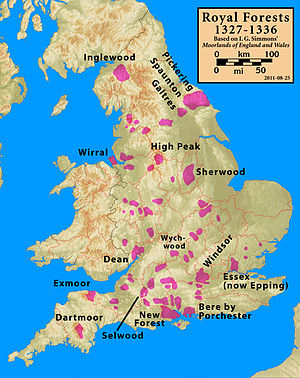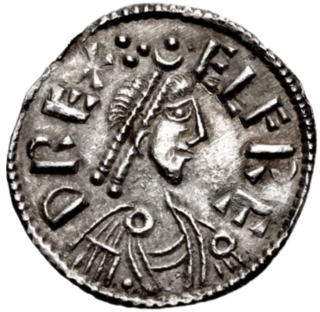
Alfred the Great was King of the West Saxons from 871 to 886, and King of the Anglo-Saxons from 886 until his death in 899. He was the youngest son of King Æthelwulf and his first wife Osburh, who both died when Alfred was young. Three of Alfred's brothers, Æthelbald, Æthelberht and Æthelred, reigned in turn before him. Under Alfred's rule, considerable administrative and military reforms were introduced, prompting lasting change in England.

The Kingdom of the West Saxons, also known as the Kingdom of Wessex, was an Anglo-Saxon kingdom in the south of Great Britain, from around 519 until Alfred the Great declared himself as King of the Anglo-Saxons in 886.

Æthelred I was King of Wessex from 865 until his death in 871. He was the fourth of five sons of King Æthelwulf of Wessex, four of whom in turn became king. Æthelred succeeded his elder brother Æthelberht and was followed by his youngest brother, Alfred the Great. Æthelred had two sons, Æthelhelm and Æthelwold, who were passed over for the kingship on their father's death because they were still infants. Alfred was succeeded by his son, Edward the Elder, and Æthelwold unsuccessfully disputed the throne with him.

Æthelwulf was King of Wessex from 839 to 858. In 825, his father, King Ecgberht, defeated King Beornwulf of Mercia, ending a long Mercian dominance over Anglo-Saxon England south of the Humber. Ecgberht sent Æthelwulf with an army to Kent, where he expelled the Mercian sub-king and was himself appointed sub-king. After 830, Ecgberht maintained good relations with Mercia, and this was continued by Æthelwulf when he became king in 839, the first son to succeed his father as West Saxon king since 641.

Æthelbald was King of Wessex from 855 or 858 to 860. He was the second of five sons of King Æthelwulf. In 850, Æthelbald's elder brother Æthelstan defeated the Vikings in the first recorded sea battle in English history, but he is not recorded afterwards and probably died in the early 850s. The next year Æthelwulf and Æthelbald inflicted another defeat on the Vikings at the Battle of Aclea. In 855, Æthelwulf went on pilgrimage to Rome and appointed Æthelbald King of Wessex, while Æthelberht, the next oldest son, became King of Kent, which had been conquered by Wessex thirty years earlier.

Æthelberht was the King of Wessex from 860 until his death in 865. He was the third son of King Æthelwulf by his first wife, Osburh. Æthelberht was first recorded as a witness to a charter in 854. The following year Æthelwulf went on pilgrimage to Rome and appointed his oldest surviving son, Æthelbald, as king of Wessex while Æthelberht became king of the recently conquered territory of Kent. Æthelberht may have surrendered his position to his father when he returned from pilgrimage but resumed the south-eastern kingship when his father died in 858.

At the Battle of Edington, an army of the kingdom of Wessex under Alfred the Great defeated the Great Heathen Army led by the Dane Guthrum sometime between 6 and 12 May 878, resulting in the Treaty of Wedmore later the same year. Primary sources locate the battle at "Eðandun". Until a scholarly consensus linked the battle site with the present-day village of Edington in Wiltshire, it was known as the Battle of Ethandun. This name continues to be used.
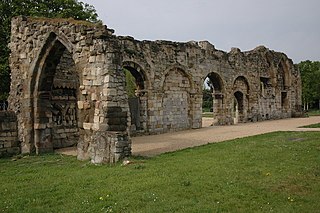
Æthelred became Lord of the Mercians in England shortly after the death or disappearance of Mercia's last king, Ceolwulf II, in 879. He is also sometimes called the Ealdorman of Mercia. Æthelred's rule was confined to the western half, as eastern Mercia was then part of the Viking-ruled Danelaw. His ancestry is unknown. He was probably the leader of an unsuccessful Mercian invasion of Wales in 881, and soon afterwards he acknowledged the lordship of King Alfred the Great of Wessex. This alliance was cemented by the marriage of Æthelred to Alfred's daughter Æthelflæd.
Ealhswith or Ealswitha was wife to King Alfred the Great. She was one of the most powerful noble women in early medieval England during the time of the Vikings. She was mother to King Edward the Elder who succeeded King Alfred to the Anglo-Saxon throne. Her father was a Mercian nobleman, Æthelred Mucel, Ealdorman of the Gaini, which is thought to be an old Mercian tribal group. Her mother was Eadburh, a member of the Mercian royal family and her lineage was one of the primary reasons for Alfred taking Ealhswith as his wife. Her legacy persists; after her death in the nunnery she founded and in the estates left to her by Alfred.
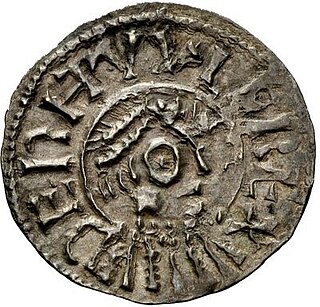
Beorhtwulf was King of Mercia, a kingdom of Anglo-Saxon England, from 839 or 840 to 852. His ancestry is unknown, though he may have been connected to Beornwulf, who ruled Mercia in the 820s. Almost no coins were issued by Beorhtwulf's predecessor, Wiglaf, but a Mercian coinage was restarted by Beorhtwulf early in his reign, initially with strong similarities to the coins of Æthelwulf of Wessex, and later with independent designs. The Vikings attacked within a year or two of Beorhtwulf's accession: the province of Lindsey was raided in 841, and London, a key centre of Mercian commerce, was attacked the following year. Another Viking assault on London in 851 "put Beorhtwulf to flight", according to the Anglo-Saxon Chronicle; the Vikings were subsequently defeated by Æthelwulf. This raid may have had a significant economic impact on Mercia, as London coinage is much reduced after 851.

Æthelwold or Æthelwald was the younger of two known sons of Æthelred I, King of Wessex from 865 to 871. Æthelwold and his brother Æthelhelm were still infants when their father the king died while fighting a Danish Viking invasion. The throne passed to the king's younger brother Alfred the Great, who carried on the war against the Vikings and won a crucial victory at the Battle of Edington in 878.
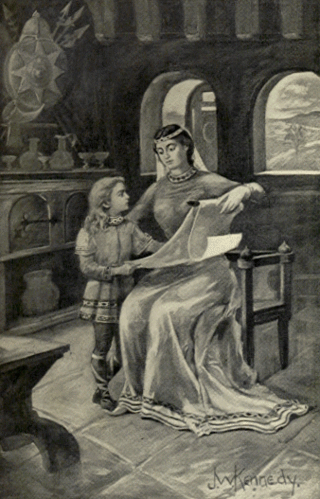
Osburh or Osburga was the first wife of King Æthelwulf of Wessex and mother of King Alfred the Great. Alfred's biographer, Asser, described her as "a most religious woman, noble in character and noble by birth".
Judith of Flanders was a Carolingian princess who became Queen of Wessex by two successive marriages and later Countess of Flanders. Judith was the eldest child of the Carolingian emperor Charles the Bald and his first wife, Ermentrude of Orléans. In 856, she married Æthelwulf, King of Wessex. After her husband's death in 858, Judith married his son and successor, Æthelbald. King Ætheldbald died in 860. Both of Judith's first two marriages were childless. Her third marriage was to Baldwin I, Margrave of Flanders, with whom she had several children.
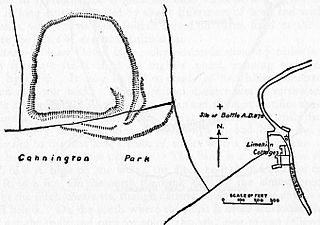
The Battle of Cynwit or Countisbury Hill took place between West Saxons and Vikings in 878. The location of the fortress the battle is named for is not known with certainty but probably was at Countisbury Hill or Wind Hill, near Countisbury, Devon. A possible alternative site for the siege and battle is Cannington Camp in the Parrett estuary near Combwich.
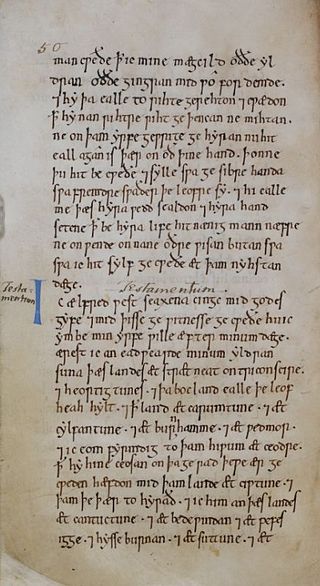
Æthelhelm or Æþelhelm was the elder of two known sons of Æthelred I, King of Wessex from 865 to 871, and Queen Wulfthryth.
Æthelstan was the King of Kent from 839 to 851. He served under the authority and overlordship of his father, King Æthelwulf of Wessex, who appointed him. The late D, E and F versions of the Anglo-Saxon Chronicle describe Æthelstan as Æthelwulf's brother, but the A, B and C versions, and Æthelweard's Chronicon, state that he was Æthelwulf's son. Some historians have argued that it is more probable that he was a brother, including Eric John in 1966 and Ann Williams in 1978. However, in 1991 Ann Williams described him as Æthelwulf's son, and this is now generally accepted by historians, including Frank Stenton, Barbara Yorke, and D. P. Kirby.

Edward the Elder was King of the Anglo-Saxons from 899 until his death in 924. He was the elder son of Alfred the Great and his wife Ealhswith. When Edward succeeded to the throne, he had to defeat a challenge from his cousin Æthelwold, who had a strong claim to the throne as the son of Alfred's elder brother and predecessor, Æthelred I.
Ealhstan was a medieval Bishop of Sherborne.
Events from the 9th century in England.
The Battle of Buttington was fought in 893 between a Viking army and an alliance of Anglo-Saxons and Welsh.
